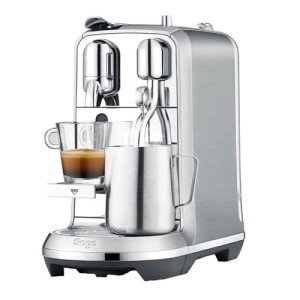Heat Exchange Espresso Machines: A Comprehensive Guide
Espresso machines have progressed considerably throughout the years, catering to the requirements of home baristas and coffee professionals alike. Among these machines, heat exchange espresso machines have actually gained appeal due to their ability to deliver consistent performance and remarkable brew quality. In this short article, we will explore the operations, advantages, and crucial features of heat exchange espresso machines, providing a comprehensive understanding for both potential purchasers and coffee lovers.
Comprehending Heat Exchange Technology
Heat exchange espresso machines run on a distinct concept that enables synchronised water heating for brewing and steaming. They are geared up with a single boiler that utilizes a heat exchanger system. This function is substantial as it enables users to brew espresso while steaming milk concurrently, promoting effectiveness in the coffee-making procedure.
How Does a Heat Exchange Espresso Machine Work?
The procedure starts with the machine's water inlet filling the boiler. As Pod Espresso Machines warms up, it turns to steam. The innovative heat exchanger uses hot steam to heat extra water in a separate passage designed particularly for the brew group. This implies that water can reach the perfect developing temperature level without waiting on the boiler to change. The essential steps include:
- Water Fill: Water is drawn into the boiler.
- Heating Process: The boiler heats up as water is transformed into steam.
- Heat Exchange: Steam heats up water in the heat exchanger tube.
- Brewing: Water from the heat exchanger is pressed through coffee premises, drawing out the tastes required for an abundant espresso.
This process permits quick temperature level changes and improved coffee extraction.
Benefits of Heat Exchange Espresso Machines
Heat exchange espresso machines provide a number of benefits, especially for those seeking to maximize their coffee experience. Here are some essential advantages:
- Simultaneous Brewing and Steaming: Users can brew espresso while steaming milk, making it ideal for hectic cafes and home baristas who value effectiveness.
- Temperature Stability: The boiler's steam pressure helps keep a stable temperature level, which is crucial for constant espresso extraction.
- Versatility: The design permits quick switching in between developing and steaming, making it much easier to create various coffee drinks, from lattes to cappuccinos.
- User-friendly: Models typically come with available controls, making it possible for both newbies and skilled baristas to produce quality beverages.
- Professional Quality: Heat exchange machines are typically utilized in commercial settings, providing users with high-quality developing performance in the house.
Key Features to Look for in Heat Exchange Espresso Machines
When thinking about the purchase of a heat exchange espresso machine, there are a number of features that a person should take into consideration:
- Build Quality: Look for machines made from resilient materials, such as stainless-steel or brass, ensuring durability.
- Boiler Size: A larger boiler will hold more water and sustain greater output gradually.
- PID Temperature Control: This function assists keep constant brew temperatures, which can improve the coffee-making procedure.
- Group Head Design: Machines with a saturated or semi-saturated group head offer much better temperature level stability.
- Relieve of Use: User-friendly interfaces and intuitive controls improve the overall experience for baristas at all ability levels.
- Steam Wand Quality: A great steam wand with proper insulation and flexibility permits for better texturing of milk.
- Water Reservoir Size: Depending on your needs, consider how frequently you desire to refill the water reservoir.
Contrast of Popular Heat Exchange Espresso Machines
To better comprehend the options readily available in the market, below is a comparison table of some popular heat exchange espresso machines:
| Machine Model | Boiler Size | PID Control | Cost Range | User Ratings |
|---|---|---|---|---|
| Profitec Pro 700 | 2.0 L | Yes | ₤ 2,000-₤ 2,500 | 9.5/ 10 |
| Rocket Espresso R58 | 1.8 L | Yes | ₤ 2,400-₤ 2,800 | 9.4/ 10 |
| Elekta Bianca | 1.8 L | Yes | ₤ 2,500-₤ 3,000 | 9.6/ 10 |
| La Spaziale S1 Vivaldi II | 1.5 L | Yes | ₤ 1,800-₤ 2,200 | 9.2/ 10 |
| Bezzera Magica | 1.2 L | No | ₤ 1,600-₤ 1,800 | 9.0/ 10 |
FAQs About Heat Exchange Espresso Machines
What is the main distinction between a heat exchange and a dual boiler espresso machine?
While both types can brew espresso and steam milk at the same time, dual boiler machines have different boilers for brewing and steaming. In contrast, heat exchange machines use a single boiler and a heat exchanger to achieve the same function.
Are heat exchange machines suitable for newbies?
Yes! Lots of heat exchange machines are created with user-friendly functions, making them available for newbies. With correct guidance and practice, users can quickly produce quality espresso.
What kind of upkeep do heat exchange espresso machines need?
Regular upkeep consists of descaling, cleaning the boiler, examining seals and gaskets, and keeping the group head clean. Regular upkeep guarantees longevity and constant performance.
Can I use a heat exchange machine for various kinds of coffee beverages?
Absolutely! Heat exchange machines allow users to develop a range of coffee beverages, including espresso, lattes, coffees, and more.
Heat exchange espresso machines represent a blend of innovation and custom, supplying coffee lovers with the tools required for crafting the ideal cup. Bean To Cup Espresso Machines to all at once brew and steam, integrated with exact temperature level control, makes them a compelling choice for both home baristas and experts. With the right knowledge on functions and maintenance, users can unlock a world of splendid coffee experiences, guaranteeing that each sip is as wonderful as the last.

